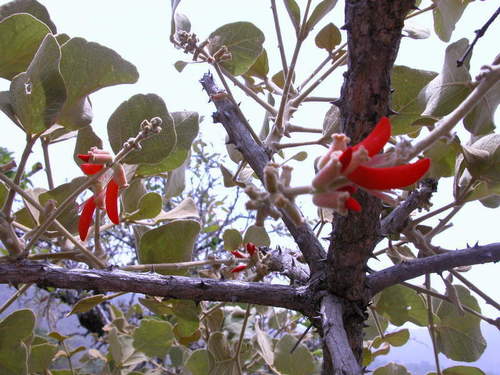Erythrina sigmoidea.

|
|
Erythrina sigmoidea Common Names: Coral Tree, Coral Bean Scientific
Classification Kingdom: Plantae Phylum: Tracheophyta Class: Magnoliopsida Order: Fabales Family: Fabaceae Genus: Erythrina Species: Erythrina sigmoidea Synonyms: Erythrina dybowskii Hua, Erythrina eriotricha Harms, Erythrina
sudanica Baker f. (Plants of the World Online, n.d.). Morphological Description Erythrina sigmoidea is a deciduous, prickly tree or shrub,
typically 3–6 meters tall, occasionally reaching 10 meters. Its armed stems and
vibrant red flowers make it a striking species. Key features include: · Stems: Thick, corky bark, brownish-yellow to cream,
armed with stout, recurved prickles; young branches densely pubescent (Useful
Tropical Plants, n.d.). · Leaves: Trifoliate, leaflets ovate to rhomboid, 8–13 cm
long, 9–15 cm wide, densely tomentose, broader than long, with prickly petioles
(World Flora Online, n.d.). · Flowers: Bright red, 3–4 cm long, in dense racemes up to
15 cm, nearly as long as leaves; flowering during rainy seasons (Kuete et al.,
2014). · Fruit: Moniliform pods, 10–20 cm long, segmented into
3–4 parts, containing 4–8 red seeds with a white hilum; fruiting post-rainy
season (Useful Tropical Plants, n.d.). · Roots: Deep, fibrous, aiding soil stabilization in
flood-prone areas (Selina Wamucii, n.d.). The tree’s prickly
nature and vivid flowers attract pollinators like birds and insects, enhancing
its ecological role (Pacific Island Ecosystems at Risk, n.d.). Distribution and Habitat Erythrina sigmoidea is native to West and Central Africa, ranging
from Senegal, Gambia, and Guinea to Cameroon, Central African Republic, and
Sudan. It occurs in: · Open
Forests: Thrives in seasonally
flooded sandy soils or forest patches with sandy-clayey hardpan (Useful
Tropical Plants, n.d.). · Savannas: Common in grassy savannas and shrublands,
tolerating gravelly soils along streams (World Flora Online, n.d.). · Elevation
Range: Found at 1,080–1,780
meters, adapting to tropical and subtropical climates with 800–1,500 mm annual
rainfall (Selina Wamucii, n.d.). Its tolerance of poor
soils and periodic flooding makes it a pioneer species in disturbed or degraded
landscapes (Pacific Island Ecosystems at Risk, n.d.). Ethnopharmacology Erythrina sigmoidea is
extensively used in West African traditional medicine, particularly in Nigeria,
Senegal, Mali, and Cameroon, for over 30 ailments, including infections,
inflammatory disorders, and cancer. Ethnopharmacological studies validate its
bioactivity, driven by flavonoids, isoflavonoids, alkaloids, and triterpenoid
saponins. Key medicinal uses include: · Anticancer: Methanol bark extracts exhibit cytotoxicity
against leukemia (CCRF-CEM, IC50 = 18.50 µg/mL), glioblastoma (U87MG, IC50 = 45
µg/mL), and colon adenocarcinoma (HCT116 p53+/+, IC50 = 19.63 µg/mL) cell
lines, attributed to isoflavonoids like sigmoidin I, abyssinone IV, and
6α-hydroxyphaseollidin; these compounds induce apoptosis via caspase activation
and reactive oxygen species (ROS) production (Kuete et al., 2014). · Antimicrobial: Leaf and bark extracts show activity against Staphylococcus aureus (MIC = 62.5 µg/mL), Escherichia coli (MIC = 125
µg/mL), and Candida albicans (MIC = 125 µg/mL), validating use for
gastrointestinal infections, venereal diseases, and leprosy; prenylated
flavonoids like sigmoidin E are key actives (Promsattha et al., 1988; Nkengfack
et al., 2000). · Anti-inflammatory: Root decoctions reduce paw edema in rats by 35%
at 200 mg/kg, linked to triterpenoid saponins (sigmosides C and D) and
flavonoids, supporting use for arthritis and rheumatism (Mbafor et al., 1997). · Antimalarial: Stem bark extracts inhibit Plasmodium
falciparum (IC50 = 10 µg/mL), attributed to alkaloids and isoflavonoids,
justifying use for fever and malaria (Fankam & Kuete, 2024). · Antidote: Aqueous leaf extracts are used for venomous
bites/stings, with alkaloids showing neuromuscular blocking activity,
potentially neutralizing toxins (Nkengfack et al., 2001). · Diuretic/Febrifuge: Bark infusions promote diuresis and reduce
fever in traditional settings, supported by saponins’ diuretic effects in rat
models (Mbafor et al., 1997). Phytochemicals include
erythrinan alkaloids (e.g., erysotrine, erythraline), isoflavonoids (e.g.,
sigmoidin I, neobavaisoflavone), flavonoids (e.g., atalantoflavone), and
triterpenoid saponins (e.g., sigmoside C), which underpin its pharmacological
versatility. However, clinical trials are lacking, and standardization of
preparations is needed (Fankam & Kuete, 2024; Son & Elshamy, 2021). ⚠ Toxicity Profile: Erythrina sigmoidea contains toxic alkaloids, particularly in
seeds, with curare-like effects that can cause paralysis or respiratory
failure. Key findings include:Acute Toxicity: Alkaloids (e.g., erysotrine) have
an LD50 of ~50 mg/kg in mice, indicating high toxicity if ingested; seeds pose
the greatest risk (Nkengfack et al., 2001). Cytotoxicity: Bark extracts show
moderate cytotoxicity to normal cells (CHO, CC50 = 15 µg/mL), suggesting
caution with prolonged use (Kuete et al., 2014). Human Risk: No documented
human fatalities, but traditional healers warn against ingesting raw seeds or
excessive bark decoctions, which may cause nausea, dizziness, or neurotoxicity
(Useful Tropical Plants, n.d.). Additional Uses · Construction: Greyish-white, lightweight wood (density ~0.4
g/cm³) is used for sieve frames, dugout canoes, surfboards, and small carvings;
low durability limits structural use (Useful Tropical Plants, n.d.). · Agriculture: Prickly stems form defensive hedges and living
fences; nitrogen-fixing roots enrich soils, benefiting agroforestry (Selina
Wamucii, n.d.). · Cultural: Red flowers and seeds are used in ornamental
crafts and rituals in Senegal and Nigeria (Pacific Island Ecosystems at Risk,
n.d.). · Ecological: Attracts pollinators and provides
shade; stabilizes soils in flood-prone areas (World Flora Online, n.d.). References
External Links More Pictures |
|
| Compounds of Erythrina sigmoidea. | |
| References |